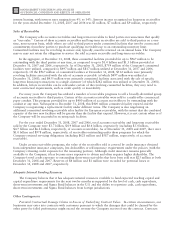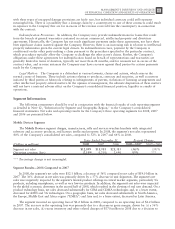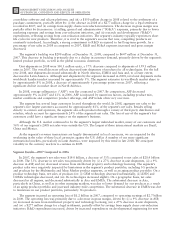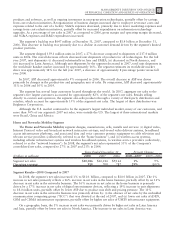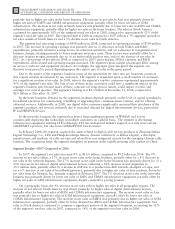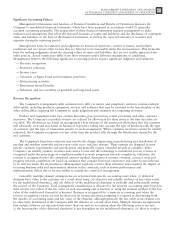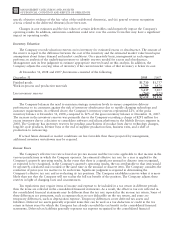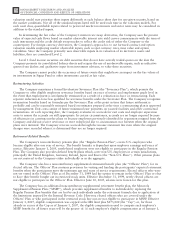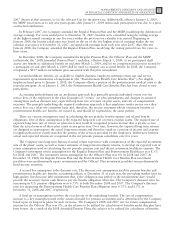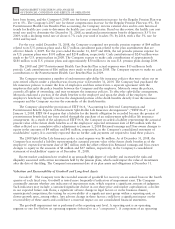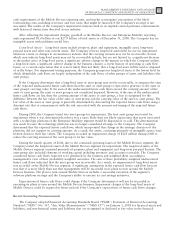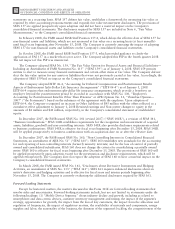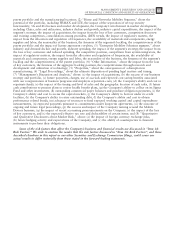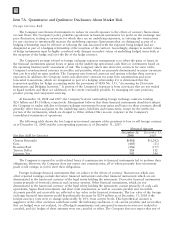Motorola 2008 Annual Report Download - page 78
Download and view the complete annual report
Please find page 78 of the 2008 Motorola annual report below. You can navigate through the pages in the report by either clicking on the pages listed below, or by using the keyword search tool below to find specific information within the annual report.
valuation model may prioritize these inputs differently at each balance sheet date for any given security, based on
the market conditions. Not all of the standard inputs listed will be used each time in the valuation models. For
each asset class, quantifiable inputs related to perceived market movements and sector news may be considered in
addition to the standard inputs.
In determining the fair value of the Company’s interest rate swap derivatives, the Company uses the present
value of expected cash flows based on market observable interest rate yield curves commensurate with the term of
each instrument and the credit default swap market to reflect the credit risk of either the Company or the
counterparty. For foreign currency derivatives, the Company’s approach is to use forward contract and option
valuation models employing market observable inputs, such as spot currency rates, time value and option
volatilities. Since the Company primarily uses observable inputs in its valuation of its derivative assets and
liabilities, they are considered Level 2.
Level 3 fixed income securities are debt securities that do not have actively traded quotes on the date the
Company presents its consolidated balance sheets and require the use of unobservable inputs, such as indicative
quotes from dealers and qualitative input from investment advisors, to value these securities.
The Company cannot predict the occurrence of future events that might have an impact on the fair values of
its investments in Sigma Fund or other investments carried at fair value.
Restructuring Activities
The Company maintains a formal Involuntary Severance Plan (the “Severance Plan”), which permits the
Company to offer eligible employees severance benefits based on years of service and employment grade level in
the event that employment is involuntarily terminated as a result of a reduction-in-force or restructuring. Each
separate reduction-in-force has qualified for severance benefits under the Severance Plan. The Company recognizes
termination benefits based on formulas per the Severance Plan at the point in time that future settlement is
probable and can be reasonably estimated based on estimates prepared at the time a restructuring plan is approved
by management. Exit costs consist of future minimum lease payments on vacated facilities and other contractual
terminations. At each reporting date, the Company evaluates its accruals for exit costs and employee separation
costs to ensure the accruals are still appropriate. In certain circumstances, accruals are no longer required because
of efficiencies in carrying out the plans or because employees previously identified for separation resigned from the
Company and did not receive severance or were redeployed due to circumstances not foreseen when the original
plans were initiated. The Company reverses accruals through the income statement line item where the original
charges were recorded when it is determined they are no longer required.
Retirement-Related Benefits
The Company’s noncontributory pension plan (the “Regular Pension Plan”) covers U.S. employees who
became eligible after one year of service. The benefit formula is dependent upon employee earnings and years of
service. Effective January 1, 2005, newly-hired employees were not eligible to participate in the Regular Pension
Plan. The Company also provides defined benefit plans which cover non-U.S. employees in certain jurisdictions,
principally the United Kingdom, Germany, Ireland, Japan and Korea (the “Non-U.S. Plans”). Other pension plans
are not material to the Company either individually or in the aggregate.
The Company also has a noncontributory supplemental retirement benefit plan (the “Officers’ Plan”) for its
elected officers. The Officers’ Plan contains provisions for vesting and funding the participants’ expected retirement
benefits when the participants meet the minimum age and years of service requirements. Elected officers who were
not yet vested in the Officers’ Plan as of December 31, 1999 had the option to remain in the Officers’ Plan or elect
to have their benefit bought out in restricted stock units. Effective December 31, 1999, newly elected officers are
not eligible to participate in the Officers’ Plan. Effective June 30, 2005, salaries were frozen for this plan.
The Company has an additional noncontributory supplemental retirement benefit plan, the Motorola
Supplemental Pension Plan (“MSPP”), which provides supplemental benefits to individuals by replacing the
Regular Pension Plan benefits that are lost by such individuals under the retirement formula due to application of
the limitations imposed by the Internal Revenue Code. However, elected officers who are covered under the
Officers’ Plan or who participated in the restricted stock buy-out are not eligible to participate in MSPP. Effective
January 1, 2007, eligible compensation was capped at the IRS limit plus $175,000 (the “Cap”) or, for those
already in excess of the Cap as of January 1, 2007, the eligible compensation used to compute such employee’s
MSPP benefit for all future years will be the greater of: (i) such employee’s eligible compensation as of January 1,
70 MANAGEMENT’S DISCUSSION AND ANALYSIS
OF FINANCIAL CONDITION AND RESULTS OF OPERATIONS


